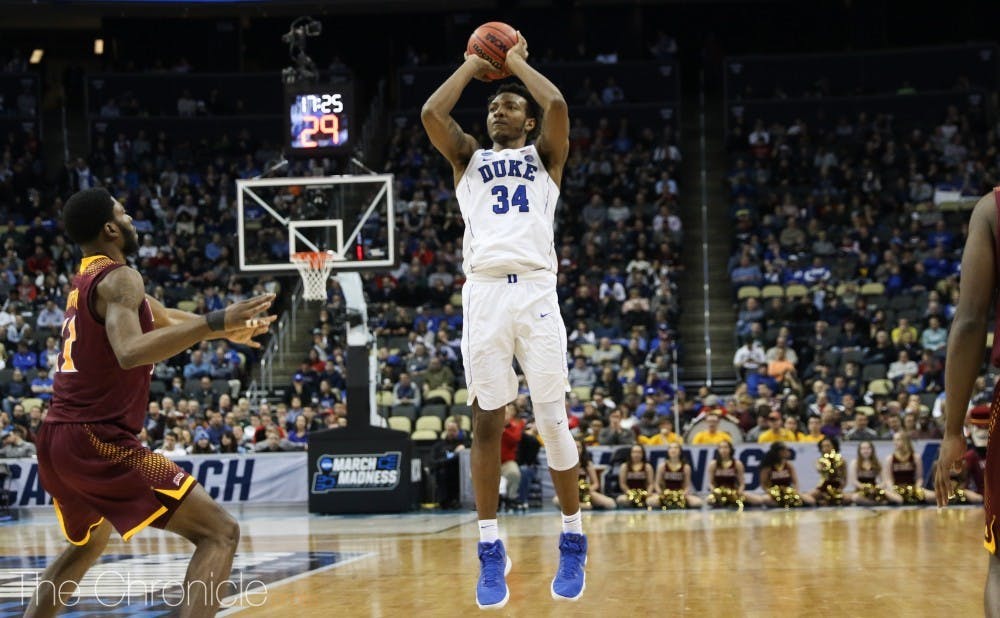PITTSBURGH—Duke's two opponents this weekend, Rhode Island and Iona, have one thing in common: They both have no starters taller than 6-foot-8.
As recently as four or five years ago, that would have put a college basketball team at a severe disadvantage.
But the game has changed so dramatically that four-guard or even five-guard lineups that can spread the floor have become the norm for some dangerous tournament teams. Even the two elite big men in the Blue Devil lineup, Marvin Bagley III and Wendell Carter Jr., have range out to the 3-point line and are not prototypical back-to-the-basket post players.
Blue Devil head coach Mike Krzyzewski suggested in his press conference on Friday's off day between games that a lot of this evolution has come from the popularization and influence of the game internationally.
"What helped the advancement of basketball, was the fact that international had a trapezoid lane, and therefore, there wasn't low post as much. So bigs were allowed—they had to learn how to play," Krzyzewski said. "Those types of things internationally helped our game to go to positionless, where everybody now is skilled with the ball or has to be. And that's why Marvin and Wendell are basketball players, not just big guys."
Duke has taken 35.8 percent of its field-goal attempts from 3-point range this season, a much higher proportion than both its guard-oriented 2010 national champion team and its 2015 title-winning squad that revolved around Jahlil Okafor in the post but still had productive shooters on the perimeter in Quinn Cook and Tyus Jones.
Yet the Blue Devils are firing away from deep far less often this season relative to the rest of the country. The national average of proportion of shots taken from beyond the arc has risen at least a full percentage point in each of the last three years, from 34.2 percent in 2014-15 to 37.5 percent this year, per basketball statistician Ken Pomeroy.
This year is only the third time since 2001-02, when Pomeroy launched his system, that Duke is below the national average in that statistic.
More than 100 teams have taken more than 40 percent of their shots via the 3-pointer this season, and it's not just a gimmick for less talented teams desperate to stay in games and be competitive—top-seeded title contender Villanova is near the top of the list at 46.7 percent.
The evolution has taken place at every level of the game, resulting in a No. 3 overall draft pick in 2015 who suddenly doesn't have a role in the NBA—sadly for Okafor—and big men like Carter and Bagley who are taught to learn guard skills from an earlier age.
"When I really started to make sure that it was a very consistent shot was getting to high school years when a lot of teams were shooting a lot of threes against us," Carter said. "I just had to learn how to shoot them, just being able to play all over the court. That’s really what I was taught from my coaches and my parents."
Both Bagley and Carter have attempted more than one triple per game this year, doing most of their damage from deep when they are trailing a play and able to step into a shot from the wing or the top of the key. The two big men have combined to convert from 3-point range at an efficient 40.8 percent clip.
"It’s been a part of my game my whole life," Bagley said. "With the team we have, I have to be inside, so I’m just doing what the team needs to win, but I think I’m very capable of playing the guard spot and making my teammates better, getting everybody else the ball and just playing."
So Rhode Island will certainly be at a size disadvantage Saturday afternoon, but that will not be a death knell for the Rams if their veteran guards get hot from the perimeter. Krzyzewski said Friday it is hard to build an ideal team, especially in an era when early departures for the NBA dilute the talent pool, but Rhode Island makes the best of what it has.
"If the game was only about height, we would be in great shape every game. The game is really about lateral quickness and how you move whatever height you have," Krzyzewski said. "They're old together at a high level. Our guys are tall and young together. The best combination is to be tall, wide and tough together for a long time. And then you would have my '92 team, or the 2001 team, or whatever. But those teams aren't alive and well anymore."
Get The Chronicle straight to your inbox
Signup for our weekly newsletter. Cancel at any time.

